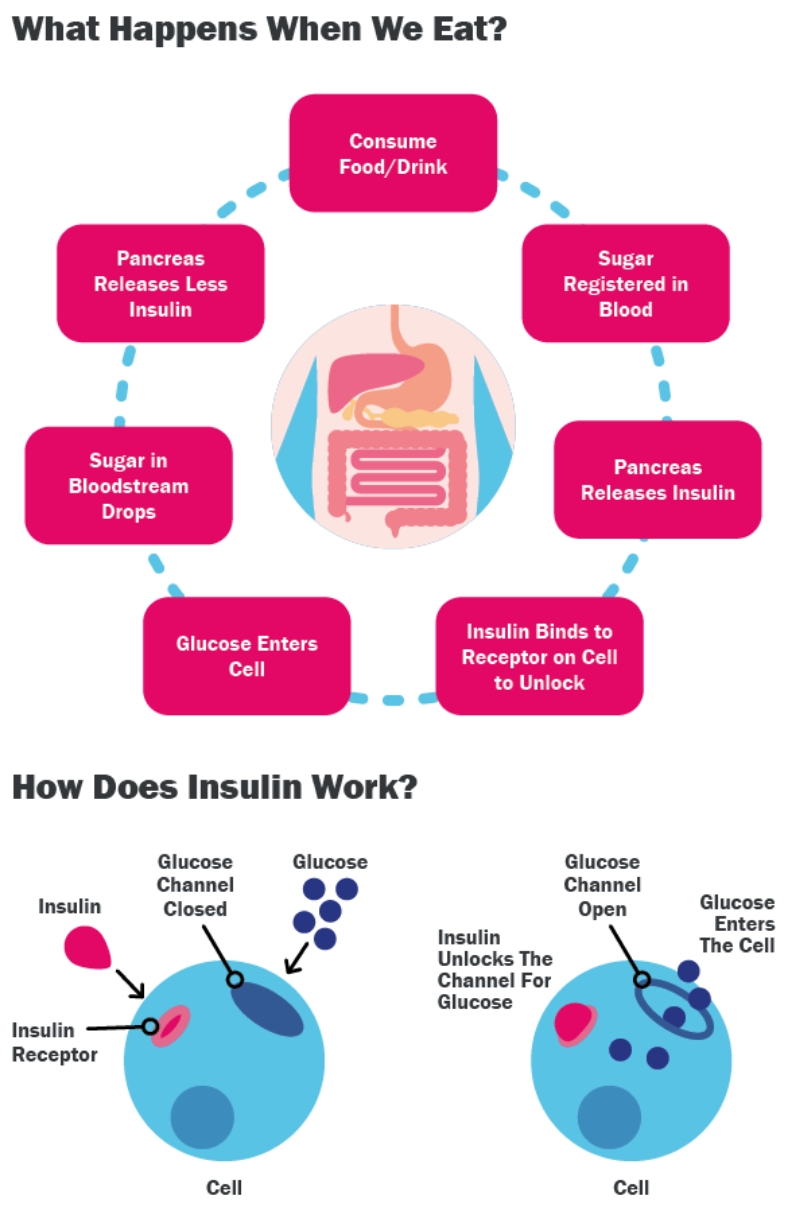It is estimated that there almost 5 million people in the UK living with diabetes, and a surprising proportion of those people do not even know they have it.
The majority of cases are due to ‘Type 2’ diabetes, which is linked to a number of other chronic health issues, such as obesity, that are on the rise globally.
What Is Diabetes?
Diabetes is often classified in two sub-groups: Type 1 and Type 2. However, a third category is emerging due to an increase in patients with dementia and Alzheimer’s, and the fact that insulin resistance within the brain is a feature of these diseases. This is often referred to as ‘Type 3’ in Functional Medicine circles.
TYPE 1 diabetes is an autoimmune disease that destroys insulin-producing cells in the pancreas. As a result, the body cannot produce enough insulin to control the amount of glucose (sugar) in the bloodstream. People are typically born with Type 1 diabetes and are often diagnosed in childhood, relying on insulin add-back for the rest of their lives.
TYPE 2 diabetes differs from Type 1 as it develops over time as a result of lifestyle factors such as poor nutrition and obesity. Due to an increased and continuous intake of highly processed foods or those high in sugar, salt and fat, the cells in the muscles, fat and liver become resistant to insulin, and are unable to open to take in glucose from the blood that is used for energy. This increased level of sugar in the blood triggers the pancreas to produce even more insulin as the body’s signals are still indicating that there is too much sugar in the bloodstream. Over an extended period, this mechanism fails, and the pancreas stops producing insulin.
Why Is Diabetes A Health Concern?
Glucose becomes toxic to the body in high quantities if it is not regulated or used by our cells as fuel.
Too much sugar circulating in the blood causes systemic damage to our blood vessels and organs, including our heart, nerves, kidneys, eyes and skin. It can also lead to an increased risk of developing dementia and Alzheimer’s.
Signs & Symptoms of Type 2 Diabetes
If you are experiencing any of the symptoms listed below, please consider making an appointment with your GP for blood tests:
- Increased thirst
- Frequent urination
- Increased hunger
- Fatigue
- Blurred vision
- Slow-healing sores
- Frequent infections
- Numbness/tingling in hands/feet
- Darkened skin under armpits/neck
- Unintended weight loss
Fortunately, a large proportion of people with pre-diabetes or Type 2 diabetes can improve their health with the aid of lifestyle changes and nutritional support, and some are even able to reverse their diagnosis altogether. Try including some of the changes below in your daily routine, the results will surprise you!
- Opt for a diet rich in whole foods, such as fruits, vegetables and foods that are high in fibre.
- Avoid ultra-processed foods containing additives, sugar alternatives, refined sugars and salt.
- Crowd out your less healthy food options with nutritious food by applying the 80/20 principle when starting to make change – 80% nutritious foods and 20% less healthy.
- Consider eating a salad or green vegetables first when you have a meal, to help regulate the blood sugar response in your body.
- Aim to move your body more during the day and build up to longer periods of exercise which raise your heart rate.
- If you are overweight, or your weight is largely positioned around your stomach, seek help to get into a healthy weight range and lower your hip-to-waist ratio.
Breakfast: Bowl of whole oats made with water and a dairy-free milk alternative, topped with frozen blueberries and chia seeds (found in Aldi and many health food stores).
Lunch: Wholemeal wrap with chicken, lettuce, tomato, cucumber and a small amount of mayonnaise. Snacks: Whole fruits, such as an apple, satsuma, or a handful of grapes. Try to avoid dried fruits as the sugar in them has been concentrated due to the removal of water.
Drinks: Water, tea, herbal teas and coffee, served black or with a dairy-free milk alternative and no added sugar or sweetener. Try to avoid carbonated soft drinks!
Dinner: Homemade vegetable curry using a variety of frozen vegetables or vegetables that you have available. Add them to a pre-made curry sauce/paste or a tin of chopped tomatoes and some curry spices.
Tip: Look for Hidden Sugars in Sauces!
Sugar is hiding in many pre-made, shop-bought sauces under the names listed below. All of these are sugars or act like sugars in the body:
- Barley malt
- Caramel
- Carob syrup
- Dextrin/dextrose
- Fructose/Lactose/Maltose
- High fructose corn syrup
- Sucrose
- Aspartame
- Sorbitol
Author: Rachel Alexander - Holistic Health Coach at Mind.Body.Wisdom

